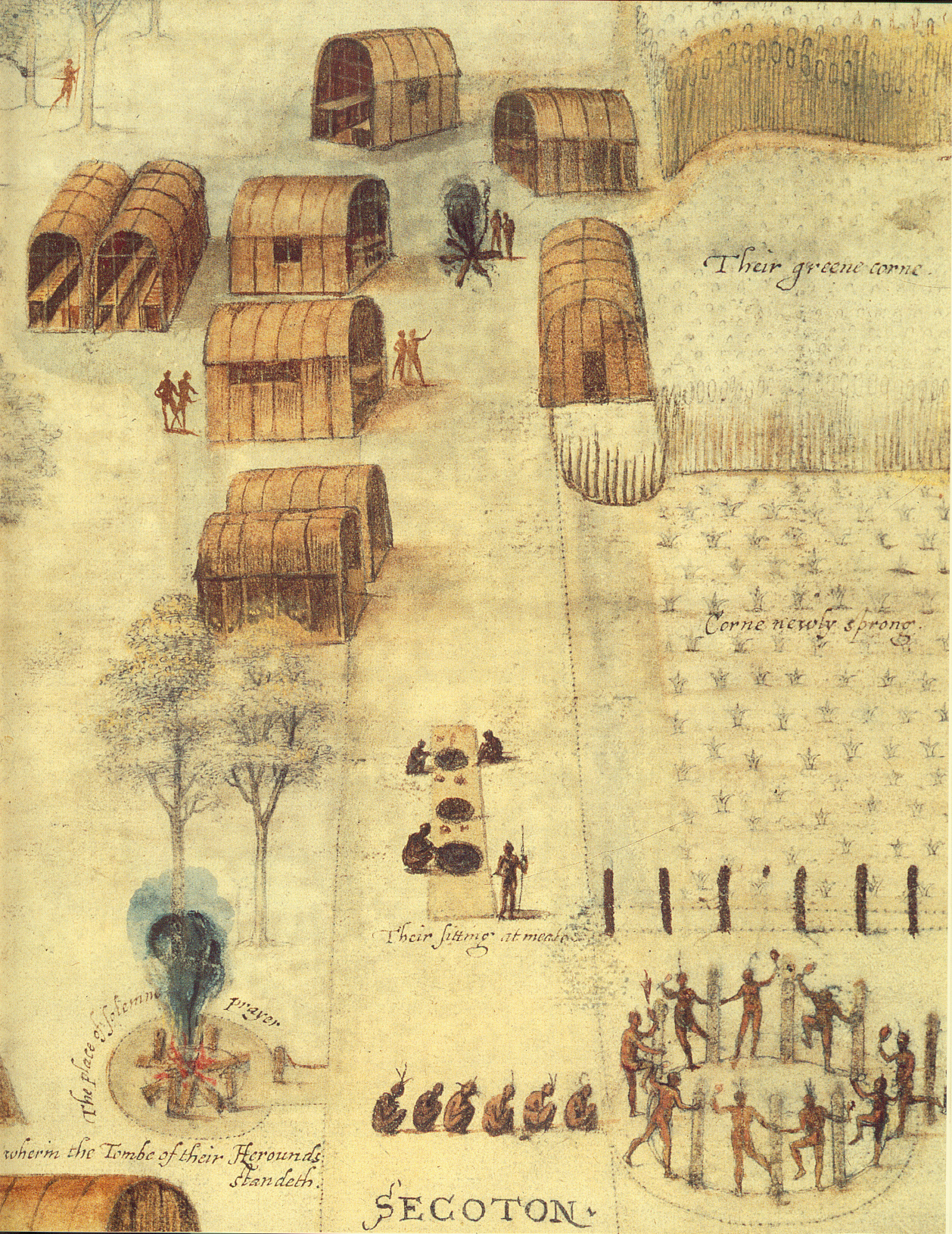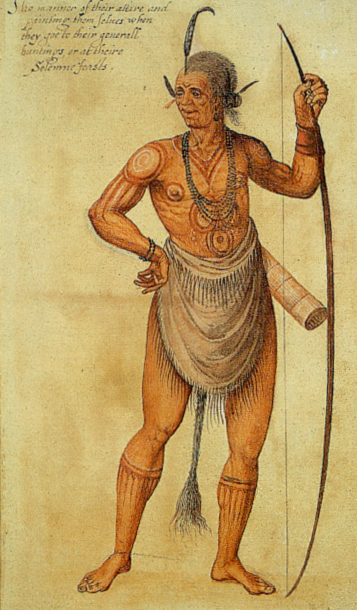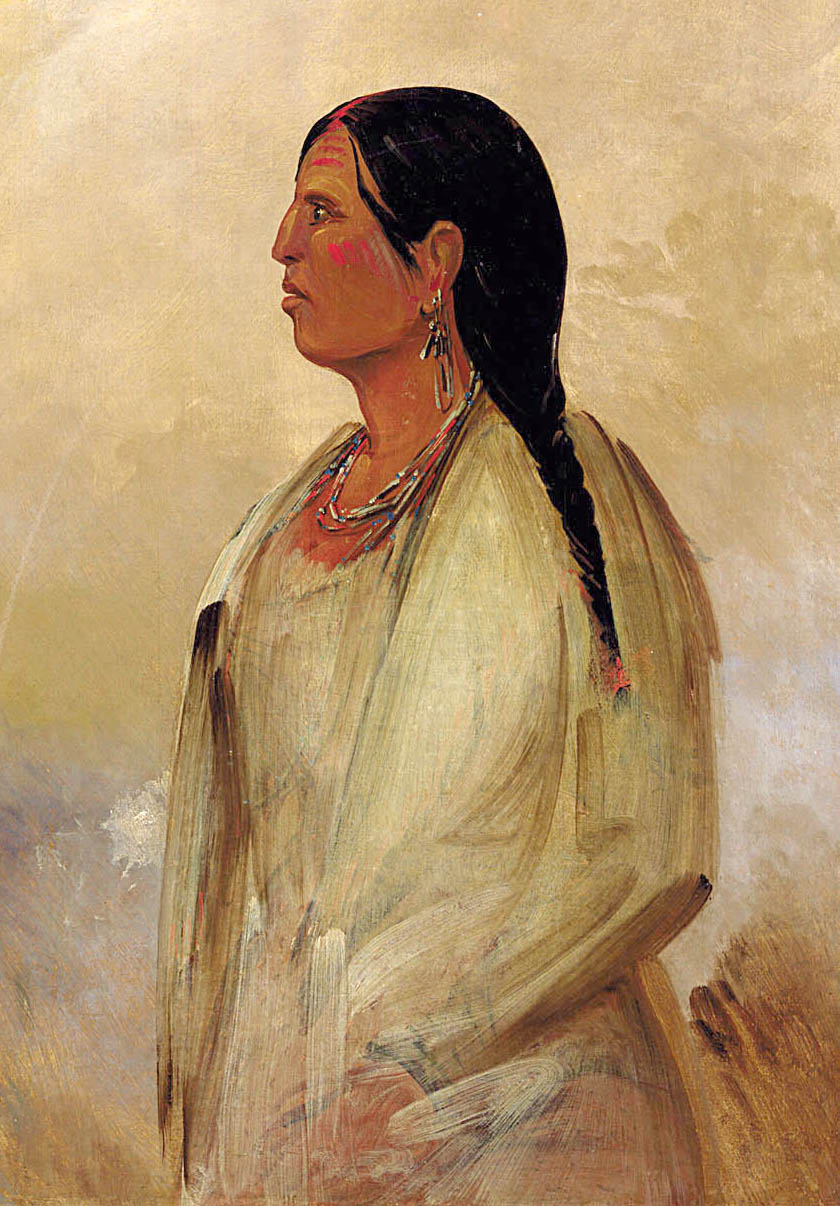|
Aquascogoc
The Aquascogoc is the name given to a Native American tribe of Secotan people and also the name of a village encountered by English colonists during their late 16th century attempts to settle and establish permanent colonies in what is now North Carolina, known at the time as Virginia. Together with the rest of Secotan people they formed a part of the Native American group known as the Carolina Algonquian Indians, and spoke the now extinct Carolina Algonquian language. In 1585 the village of Aquascogoc was burned by Sir Richard Grenville, in retaliation for the alleged theft of a silver drinking vessel. Roanoke colony Sir Richard Grenville was the leader of the 1585 expedition which first attempted to land English settlers on Roanoke island. Guided by Chief Manteo, Grenville arrived at the village but the inhabitants showed little inclination to meet with him, and the settlers soon returned to their boats. However, a silver drinking cup was found to be missing, and was belie ... [...More Info...] [...Related Items...] OR: [Wikipedia] [Google] [Baidu] |
Dasamongueponke
The Dasamongueponke (or Dasamonguepeuk) is the name given to a Native American tribe of Secotan people and also the name of a village encountered by the English during their late 16th century attempts to settle and establish permanent colonies in what is now North Carolina, known at the time as Virginia. Together with the rest of Secotan people they formed a part of the Native American group known as the Carolina Algonquian Indians, and spoke the now extinct Carolina Algonquian language. Dasamongueponke in Carolina Algonquin means "where the extended land is surrounded by water. Roanoke colony Sir Richard Grenville was the leader of the 1585 expedition which first attempted to land English settlers on Roanoke island. When war between the Secotan and the English began, King Wingia used the village as his base of operations to attack the colony. When Grenville left Roanoke, he left behind fifteen men, battle-hardened soldiers. When Governor John White retu ... [...More Info...] [...Related Items...] OR: [Wikipedia] [Google] [Baidu] |
Richard Grenville
Sir Richard Grenville (15 June 1542 – 10 September 1591), also spelt Greynvile, Greeneville, and Greenfield, was an English privateer and explorer. Grenville was lord of the manors of Stowe, Cornwall and Bideford, Devon. He subsequently participated in the plantations of Ireland, the English colonisation of the Americas and the repulse of the Spanish Armada. Grenville also served as Member of Parliament for Cornwall, High Sheriff for County Cork and Sheriff of Cornwall. In 1591, Grenville died at the battle of Flores fighting against an overwhelmingly larger Spanish fleet near the Azores. He and his crew on board the galleon fought against the 53-strong Spanish fleet to allow the other English ships to escape. Grenville was the grandfather of Sir Bevil Grenville, a prominent military officer during the English Civil War. Origins Richard Grenville was the eldest son and heir of Sir Roger Grenville (d. 1545), who was captain of when it sank in Portsmouth Harbour i ... [...More Info...] [...Related Items...] OR: [Wikipedia] [Google] [Baidu] |
John White (colonist And Artist)
John White () was an English colonial governor, explorer, artist, and cartographer. White was among those who sailed with Richard Grenville in the first attempt to colonize Roanoke Island in 1585, acting as artist and mapmaker to the expedition. He would most famously briefly serve as the governor of the second attempt to found Roanoke Colony on the same island in 1587 and discover the colonists had mysteriously vanished. During his time at Roanoke Island he made several watercolor sketches of the surrounding landscape and the native Algonkin peoples. These works are significant as they are the most informative illustrations of a Native American society of the Eastern seaboard; the surviving original watercolors are now preserved in the print room of the British Museum. In 1587, White became governor of Sir Walter Raleigh's failed attempt at a permanent settlement on Roanoke Island, known to history as the "Lost Colony". This was the earliest effort to establish a perm ... [...More Info...] [...Related Items...] OR: [Wikipedia] [Google] [Baidu] |
Secotan
The Secotans were one of several groups of American Indians dominant in the Carolina sound region, between 1584 and 1590, with which English colonists had varying degrees of contact. Secotan villages included the Secotan, Aquascogoc, Dasamongueponke, Pomeiock (Pamlico) and Roanoac. Other local groups included the Chowanoke (including village Moratuc), Weapemeoc, Chesapeake, Ponouike, Neusiok, and Mangoak (Tuscarora), and all resided along the banks of the Albemarle and Pamlico sounds. They spoke Carolina Algonquian language, an Eastern Algonquian language. Background In the Carolinas, colonization did not exist as a straight-line transition, from Native American to European rule. A rivalry marked the relationship between the two European powers, the English and the Spanish. Rivalries also existed between the Native American groups. Additionally, the Europeans often found themselves caught in the middle of conflicts, which existed between Native American groups. Each gr ... [...More Info...] [...Related Items...] OR: [Wikipedia] [Google] [Baidu] |
Carolina Algonquian Language
Carolina Algonquian (also known as Pamlico, Croatoan) was an Algonquian language of the Eastern Algonquian subgroup formerly spoken in North Carolina, United States. Carolina Algonquian was formerly spoken by Secotan (later known as Machapunga), Chowanoke and Weapemeoc (subgroups Poteskeit and Paspatank) peoples. Translation into English In 1584 Sir Walter Raleigh had dispatched the first of a number of expeditions to Roanoke Island to explore and eventually settle the New World. Early encounters with the natives were friendly, and, despite the difficulties in communication, the explorers were able to persuade "two of the savages, being lustie men, whose names were Wanchese and Manteo" to accompany them on the return voyage to London, in order for the English people to report both the conditions of the New World that they had explored and what the usefulness of the territory might be to the English Once safely delivered to England, the two Indians quickly made a sensation a ... [...More Info...] [...Related Items...] OR: [Wikipedia] [Google] [Baidu] |
North Carolina
North Carolina () is a state in the Southeastern region of the United States. The state is the 28th largest and 9th-most populous of the United States. It is bordered by Virginia to the north, the Atlantic Ocean to the east, Georgia and South Carolina to the south, and Tennessee to the west. In the 2020 census, the state had a population of 10,439,388. Raleigh is the state's capital and Charlotte is its largest city. The Charlotte metropolitan area, with a population of 2,595,027 in 2020, is the most-populous metropolitan area in North Carolina, the 21st-most populous in the United States, and the largest banking center in the nation after New York City. The Raleigh-Durham-Cary combined statistical area is the second-largest metropolitan area in the state and 32nd-most populous in the United States, with a population of 2,043,867 in 2020, and is home to the largest research park in the United States, Research Triangle Park. The earliest evidence of human occupation i ... [...More Info...] [...Related Items...] OR: [Wikipedia] [Google] [Baidu] |
Native Americans In The United States
Native Americans, also known as American Indians, First Americans, Indigenous Americans, and other terms, are the Indigenous peoples of the mainland United States ( Indigenous peoples of Hawaii, Alaska and territories of the United States are generally known by other terms). There are 574 federally recognized tribes living within the US, about half of which are associated with Indian reservations. As defined by the United States Census, "Native Americans" are Indigenous tribes that are originally from the contiguous United States, along with Alaska Natives. Indigenous peoples of the United States who are not listed as American Indian or Alaska Native include Native Hawaiians, Samoan Americans, and the Chamorro people. The US Census groups these peoples as " Native Hawaiian and other Pacific Islanders". European colonization of the Americas, which began in 1492, resulted in a precipitous decline in Native American population because of new diseases, wars, ethni ... [...More Info...] [...Related Items...] OR: [Wikipedia] [Google] [Baidu] |
Indigenous Peoples Of The Southeastern Woodlands
Indigenous peoples of the Southeastern Woodlands, Southeastern cultures, or Southeast Indians are an ethnographic classification for Native Americans who have traditionally inhabited the area now part of the Southeastern United States and the northeastern border of Mexico, that share common cultural traits. This classification is a part of the Eastern Woodlands. The concept of a southeastern cultural region was developed by anthropologists, beginning with Otis Mason and Frank Boas in 1887. The boundaries of the region are defined more by shared cultural traits than by geographic distinctions.Jackson and Fogelson 3 Because the cultures gradually instead of abruptly shift into Plains, Prairie, or Northeastern Woodlands cultures, scholars do not always agree on the exact limits of the Southeastern Woodland culture region. Shawnee, Powhatan, Waco, Tawakoni, Tonkawa, Karankawa, Quapaw, and Mosopelea are usually seen as marginally southeastern and their traditional lands repre ... [...More Info...] [...Related Items...] OR: [Wikipedia] [Google] [Baidu] |
Pamlico
The Pamlico (also ''Pampticough'', ''Pomouik'', ''Pomeiok'') were American Indians of North Carolina. They spoke an Algonquian language also known as ''Pamlico'' or ''Carolina Algonquian''. Geography The Pamlico Indians lived on the Pamlico River in North Carolina. Named after them were Pamlico Sound, the largest sound in North Carolina, and Pamlico County. They are one of the most southerly Algonquian tribes on the Atlantic seaboard and the most southerly ones for which scholars collected a vocabulary. History The Raleigh colonists referred to the Pamlico in 1585-86 by the name ''Pomoui''. 17th century history In 1696, smallpox, called "A great Mortality", devastated the Pamlico and neighboring Algonquian communities and reduced their populations. In 1701 the explorer John Lawson noted their Algonquian language and vocabulary (Lawson, 1860). By 1710 the Pamlico people were so limited that they lived in a single small village. By 1709 the total North Caroli ... [...More Info...] [...Related Items...] OR: [Wikipedia] [Google] [Baidu] |
Algonquian Peoples
The Algonquian are one of the most populous and widespread North American native language groups. Historically, the peoples were prominent along the Atlantic Coast and into the interior along the Saint Lawrence River and around the Great Lakes. This grouping consists of the peoples who speak Algonquian languages. Before Europeans came into contact, most Algonquian settlements lived by hunting and fishing, although quite a few supplemented their diet by cultivating corn, beans and squash (the " Three Sisters"). The Ojibwe cultivated wild rice. Colonial period At the time of the first European settlements in North America, Algonquian peoples occupied what is now New Brunswick, and much of what is now Canada east of the Rocky Mountains; what is now New England, New Jersey, southeastern New York, Delaware and down the Atlantic Coast through the Upper South; and around the Great Lakes in present-day Minnesota, Wisconsin, Michigan, Illinois, Indiana and Iowa. The homeland of th ... [...More Info...] [...Related Items...] OR: [Wikipedia] [Google] [Baidu] |
Theodore De Bry
Theodor de Bry (also Theodorus de Bry) (152827 March 1598) was an engraver, goldsmith, editor and publisher, famous for his depictions of early European expeditions to the Americas. The Spanish Inquisition forced de Bry , a Protestant, to flee his native, Spanish-controlled Southern Netherlands. He moved around Europe, starting from his birth on the city of Liège in the Prince-Bishopric of Liège, then to Strasbourg, Antwerp, London and Frankfurt, where he settled. De Bry created a large number of engraved illustrations for his books. Most of his books were based on first-hand observations by explorers, even if De Bry himself, acting as a recorder of information, never visited the Americas. To modern eyes, many of the illustrations seem formal but detailed. Life Theodorus de Bry was born in 1528 in Liège, Prince-Bishopric of Liège (in modern Belgium), to a family which had escaped the destruction of the city of Dinant in 1466 during the Wars of Liège by the Duke of ... [...More Info...] [...Related Items...] OR: [Wikipedia] [Google] [Baidu] |
Engraving
Engraving is the practice of incising a design onto a hard, usually flat surface by cutting grooves into it with a burin. The result may be a decorated object in itself, as when silver, gold, steel, or glass are engraved, or may provide an intaglio printing plate, of copper or another metal, for printing images on paper as prints or illustrations; these images are also called "engravings". Engraving is one of the oldest and most important techniques in printmaking. Wood engraving is a form of relief printing and is not covered in this article, same with rock engravings like petroglyphs. Engraving was a historically important method of producing images on paper in artistic printmaking, in mapmaking, and also for commercial reproductions and illustrations for books and magazines. It has long been replaced by various photographic processes in its commercial applications and, partly because of the difficulty of learning the technique, is much less common in printmaking, wher ... [...More Info...] [...Related Items...] OR: [Wikipedia] [Google] [Baidu] |








.png)


